
記憶の方舟
Mementos of Happiness
大震災から10年を迎えた原発立地町の福島県大熊町。
残されたものたちがやがて語り始めた幸福の記憶—。
Ten years after the disaster, while taking photographs of Okuma-machi in Fukushima prefecture, where the Fukushima Daiichi Nuclear Power Station is located, I began to hear tender voices, speaking of bygone, happy days…
2019年の夏から1年あまりにわたり福島県の大熊町を撮ってきました。大熊町は福島第一原子力発電所の1号機から4号機の所在地であり、2011年の原子力発電所の事故により、立ち入りはなおも厳しく規制されています。
このように外からは見えにくい状況の中で、除染や放射性廃棄物関連施設の建設のためにかつての町は壊されつつあります。その一方、保育園、小学校、中学校、高齢者施設、個人のお宅などでは、まるで神隠しにあったかのように、その直前まで人がいた痕跡が10年近くの時を経てまだそのままに残されているところがあります。
そういった場所に身をおいて、私は当初、ただ気圧されていました。「不条理」という言葉が繰り返し頭に浮かびます。訪れられることもまれになった場所に残されたものたちから、その理由を厳しく問われているようでした。答えられるはずもなく、私はただ、見たという事実を自分に課すために写真を撮りました。
それでも、何度か訪れるうちに、そのものたちから向けられる目は少しずつやわらかくなっていきました。撮る側から壁を超えて撮られる側に迎えてもらえた気がします。伝達者の役割を意識するようになった私に、なじみになったものたちが徐々に語り始めたのは、幸福の記憶でした。
大熊のことに触れようとすると、さまざまな事情が重層的に絡み合います。目を向けなければならない問題はたくさんあります。それでも、どんな形であれ、人が不条理に直面した時、乗り越える力になってくれるものがあるとしたら、 小さな幸福の記憶のかけらが、そのはじまりになってくれるのではないか — 訥々と紡がれる言葉を聞きながら、私は祈るように、そう信じたいと思いました。
プリントは、千年以上の歴史を持つ福島県の手漉き和紙、上川崎和紙に乳剤を塗布して行っています。産地である二本松市では、職人さんが自らの土地で楮を育て、伝統の手法で紙漉きを続けています。土地のぬくもりをたたえる生成色の紙に支えられて、大熊の記憶はやわらかく立ち上るようです。同じネガでもプリントはその都度違うものになり、それは人の数だけ思い出があることを示しているようでもありました。
For over a year, starting in the summer of 2019, I took photographs of Okuma-machi, a town in Fukushima Prefecture. Okuma is where the Fukushima Daiichi Nuclear Power Station is located. After the enormous earthquake/tsunami disaster of March 11th, 2011, the town was completely evacuated; since then, for most people, entry to the town is strictly prohibited. Fortunately, a personal connection permitted me to enter the area in my capacity as a photographer.
In such a totally shut-down situation, the town is gradually, continually being destroyed due to decontamination procedures and the construction of radioactive waste treatment facilities. However, there still exist many areas where everything is left just as it was ten years ago. In these places, it can seem as if the people were suddenly spirited away, with vital belongings left untouched. Visiting the kindergarten, the elementary school, the junior high school, the care home for the elderly, private houses, and so on, I could clearly see how their daily lives were up until that sudden, complete evacuation.
The word "baffling" often came to my mind. I felt as if the possessions that were randomly left behind, such as small futons for children, school bags, and family photos, cried out for some kind of explanation. I could not find any answers in my mind - so I simply took many photographs, to prove to myself that I had seen these abandoned objects.
However, as I continued to revisit Okuma-machi, things started to feel somehow different. I thought I began to hear tender voices, speaking of bygone, happy days. On sensing these benevolent voices, I felt somehow that I had crossed a border and joined them on their side, transforming myself from someone who takes photographs to a person or object to be photographed. At that point, I stopped being an observer or auteur, and became an interpreter or transmitter.
When I talk about the tragedy of Okuma, I have complex, sometimes contradictory feelings, which are unavoidable, and sometimes difficult to express. But when I try to look deeply into my heart, I find that what I really want to share is this: when a person is confronted with a baffling event, in whatever way, even the smallest happy memories will provide the strength to overcome it and find peace.
To create these works, I used Kamikawasaki washi, hand-screened Japanese paper which has been manufactured for over 1000 years in Nihonmatsu in Fukushima prefecture. The craftspeople there still grow kozo (paper mulberry) plants in the fields, for the purpose of making paper according to traditional methods. I applied photographic emulsion to this paper, and printed the images in my own darkroom. From the warm-toned ecru-coloured paper imbued with the organic energy of its source, the memories of the land seemed to arise gently and naturally. Even when printing and reprinting the same negative, I achieved a different result each time, which may indicate that the memories held in the paper are as numerous as the people who lived in the area.

























